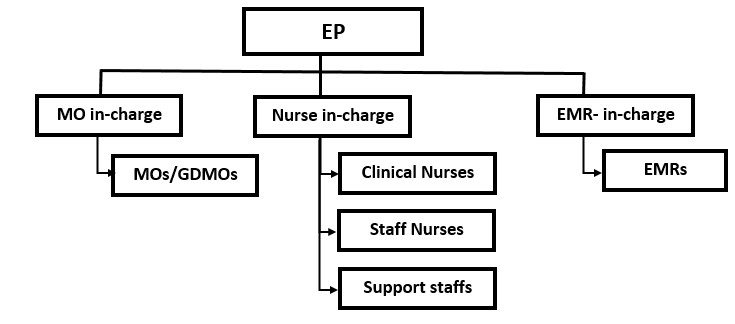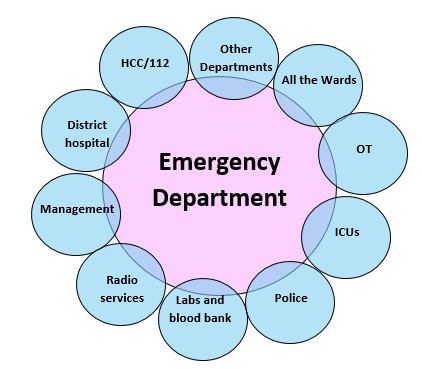- Introduction
The emergency department(ED) is a core clinical unit of a hospital and the experience of patients attending the department significantly influences patient satisfaction and the public image of the hospital. Its function is to receive, triage, stabilize and provide emergency management to patients who presents with a wide variety of critical, urgent and semi urgent conditions. The department also provides for the reception and management of disaster patients.
The ED of ERRH was established in 2008. The department consists of a team of Emergency Physician (EP), General Duty Medical Officers (GDMOs), clinical nurses, staff nurses, Emergency Medical Responders (EMR) and supporting staff. This team is available twenty-four hours a day, seven days a week, to treat any patient seeking emergency medical care.
Emergency Care includes adult medical and pediatric resuscitation, trauma resuscitation, toxins and overdoses and the treatment of minor urgencies. Resuscitation and critical care including but not limited acute coronary artery disease, acute stroke, sepsis, acute abdominal pain, bronchial asthma/COPD, toxic ingestions and trauma.
All patients who present to the Emergency Department are triaged according to seriousness of their conditions into three levels of triage [Red (1), Yellow (2), Green (3)]. Currently we do not have a separate triage area as the case load are comparatively low and all patients are triage at the bed side or at the treatment area. These levels of triage allow the emergency team to give priority to life-threatening conditions. The emergency team consults specialists in other medical and surgical fields as required.
- Vision
A center of excellence in the teaching and provision of emergency medicine and the development of bests in Emergency Healthcare
Mission
- To provide effective and high-quality emergency care for patients with acute and potentially life-threatening conditions.
- To nurture and assist professional development for all staff at all professional levels
- To set the highest standards of emergency medicine practice
- To encourage and support high-quality, practice-changing research
- To maintain high level of quality services that would contribute to ensure public trust and confidence
- Mandates
- To provide emergency services 24 hours a day, 7 days a week.
- To accurately and efficiently triage patients and to provide immediate and life-saving medical care to those who require it.
- To provide rapid resuscitation, stabilization and referral of critically ill and injured patients.
- To engage in inter-departmental collaboration and coordination.
- To be prepared for disaster and mass casualties
- To teach interns, medical officers and residents
Department Unit
Clinical Services Units in the department are:
5.1. Triage
Every emergency department has a triage or triaging area to sort incoming patients. Triage can be defined as the prioritization of patient care based on the severity of injury / illness, prognosis, and availability of resources. For those responsible for the triage of patients arriving in the emergency department, the purpose of triage is to determine to which predesignated patient care area the patient should be sent.
Triage of every patient coming to ED where the “waiting time to be seen” by an ED doctor is based on the individual medical condition of the patient. We categorize all patients presenting to ED into three Priorities.
- P1 (Red) seen immediately in Resuscitation Area
(Examples: Airway compromise, tension pneumothorax, shock, cardiac arrest, seizures, etc.)
- P2 (Yellow) seen within 30 minutes in AMC
(Examples: Limb injuries, lacerations with hemorrhage controlled, high fever, altered sensorium, and severe pain)
- P3 (Green) seen by 60 minutes or more.
(Examples: Sore throat, abrasions and superficial lacerations, chronic self-limiting disorders
5.2. Resuscitation Unit
This area is dedicated to the immediate care of patients and victims in cardiac arrest, airway, and breathing and circulation compromise. The ‘Resus’ area consists one adult and one pediatric bed with all resuscitative equipment (monitors, defibrillators, airway, intubation & surgical equipment). All priority I patients are managed here
5.3. Acute Care Unit
Patients, who are sick and non-ambulant requiring urgent care will be triaged here. They will be triage here and are required to be seen within 30 minutes.
All priority II patients are managed here. Majority of the ED admitted patients are assessed and managed here.
5.4. Observation Area
Patients requiring observation for less than 24 hours will be kept here
5.5. Procedure Room
Both major and minor procedure are done in this area. Major procedure includes central line insertion, HD line, intercostal tube and reduction of fracture and dislocation with procedure sedation. The area is equipped with monitor, oxygen, and suction and airway equipment for any procedure related complications. Minor dressing and suturing is all done in this area.
5.6. Consultation room/ Green Area
Here the walk-in ambulatory patients who need minor care and can be sent home are seen. They are P3 patients, waiting time being 60 minutes or more
5.7. Emergency Pre-Hospital care
This is manned by Emergency Medical Responder and they respond to ambulance call with basic pre-hospital Care.
Future unit plan
- Dedicated triage area
- CME room for teaching and learning
- Sim’s Lab
- Fully digitalized emergency department for data and information
6. Organogram

7. Collaboration
Emergency department has to have collaboration with different hospital, department and organization for smooth functioning and for effective and efficient patient care.

8. Services available
- Acute Adult medical care
- Acute Pediatric care
- Trauma care and resuscitation
- Toxins and drug overdose management
- Emergency imaging and labs
- EMS and Rapid response team
- Forensic evaluation and reporting
- First Aid training
- Minor OT and procedure room
- PEN HEARTS NCD screening and Counselling
- Way forward
- Improve Emergency physician coverage by more number of EPs and EM residents.
- Improving human resources with more dedicated ED GDMOS/MOs, trained nurses and EMRs
- Expansion and Remodeling of Emergency Department to improve the patient care with area with better/more monitors, separate minor and major procedure rooms, dedicated triage area, patient counseling room, isolation room; waiting room, expand observation and acute care unit.
- Improve Emergency Department Information System that will provide valuable data and help in planning Human resources and equipment.
- Improve on emergency diagnostic and laboratory services
- Improve EMS services by increasing the numbers of EMRs, better equipment and communication, initiate/start aero medical services (collaborate with BEAR/112).
